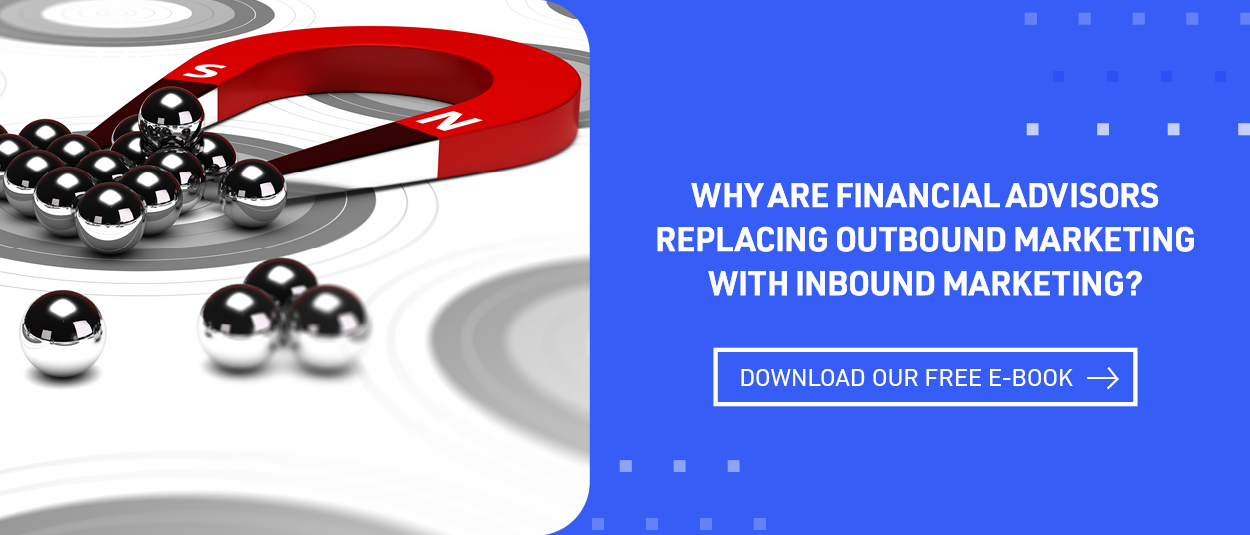

How Does a Financial Advisor Digital Marketing Sales Funnel Work?
Along your financial advisor digital marketing journey, you may have at times asked yourself how all of these efforts will lead to your ultimate goal: new clients. While digital marketing efforts in other industries can at times produce instantaneous results (retail; buy or don’t buy) that doesn’t mean that digital marketing isn’t worth the effort for financial advisors. It simply means that you, as the digital marketer, need to help your prospects through what’s known as a sales funnel.
While it may sound unusual, a sales funnel is simply a way of describing the process of a customer from the first stage of awareness to conversion. In this context, a conversion is a “sale” or in the case of a financial advisor, the same as someone signing a service agreement and becoming a client. Think of an actual funnel that starts out wide and then narrow to only let the desired prospects through.
Back in the day, this marketing process was also called pipe theory. That is, investors go in one end of the pipe and come out the other end with a Yes (client), No, or Maybe (drip list). What happens inside the pipe was the key to the advisors’ success converting names into clients.
Your sales funnel will lead prospects from the first stage of awareness, through multiple marketing stages – and yes, some people will get filtered out during this process – leaving you with only the best prospects who are potential clients.
So how do you establish the right digital marketing sales funnel for your clients? And how can you make sure you’re not losing potential clients along the way?
Read on for how a financial advisor digital marketing sales funnel works and how you can get started.
What are the critical parts of a financial advisor digital marketing sales funnel?
-
Foundation:
Just as the name implies, the foundation of a sales funnel is your ideal types of clients. Have you identified your ideal types of clients and created a strategy for targeting those types of potential clients on the Internet?
A successful sales funnel includes an in-depth understanding of your target audience, including who they are, what are unique identifiers, and most importantly, what financial pain points they have and how you as a financial advisor can solve them.
-
Floodgates:
A floodgate is another word for the source by which prospective clients will find your financial advisor firm on the Internet. Depending on the extent of your digital marketing efforts, this could be SEO, SEM (paid search ads), social media channels, and most importantly – content marketing such as videos, blogs, infographics, whitepapers, eBooks, and other types of published works.
-
Funnel:
The actual funnel itself is where the traffic is directed to. This is usually triggered by the above steps. For example, if someone searched for a financial advisor, was presented with your site in the results through your SEO efforts, clicks on your website, and ultimately downloads a whitepaper on your website after giving you their contact information, they have entered the sales funnel. You now have the opportunity to reach out and nurture that prospect and guide them through the remaining stages of the funnel.
If you’ve taken the above actions, you now have prospective clients in your sales funnel. Now, you will be moving them through the next stages of the funnel. Technology helps in this regard because you can have a large number of prospects in the funnel at various stages.
What do financial advisors need to know about the basic stages of the client journey?
The first thing to know is the basic stages of the customer or “client” journey within the funnel itself: AIDA(A). This stands for Awareness, Interest, Desire and Action.
Source: HubSpot
Stage #1: Awareness
As mentioned briefly above, awareness is simply the prospect or targeted client becoming aware of your firm’s existence. After all, they can’t become a prospect if they don’t know you exist. This awareness can be measured by your visibility on the Internet - how many relevant keywords you rank for. As the shape of the funnel illustrates, this is the top stage and the point at which every potential client starts.
Stage #2: Interest
Moving on through the funnel, the next stop is the interest stage. This is where a prospect takes an additional step beyond awareness, such as becoming a follower on social media or taking some other action to engage with your firm. This is the point at which the prospect goes from simply being aware of your firm, to being a potential lead who needs your advice and services.
Stage #3: Desire
This is where your content marketing can make or break your conversion strategy. Why? Because this is the stage where leads become actual prospects who take a deeper dive into your business and learn more about what you have to offer. In this case, the definition of a prospect is an investor who has acknowledged he or she has some level of interest in the services of your firm.
It’s crucial that financial advisors utilize their website content to show prospects what makes them different from their competitors and show their credentials, awards, qualifications, and any niche areas or areas of specialization. This is because during this stage most prospects are comparing you to your competition and you have to stand out in a positive manner to get them to contact you.
Stage #4: Action
This is the point at which a prospect takes the next (or sometimes final) step to becoming a conversion. For businesses selling a tangible product, this is usually the point where they make a purchase. For service-based businesses such as financial advisors, this might take the form of a prospect reaching out for an interview via phone or Zoom or even messaging on social media.
Bonus: Advocacy
While not part of the traditional AIDA, this extra “A” for Advocacy is the point in which a client has become an advocate for your brand. As a financial advisor, you already understand the importance of a referral from an existing client to a friend, family member, or associate.
That’s because financial advising services are highly personal, and people tend to take the word of trusted family and friends when it comes to hiring someone to manage their financial future. Sure, friends might recommend their favorite restaurant but gaining a new client as a result of another successful client relationship is much more involved and should be the ultimate goal of any financial advisor.
While it may seem like there are way too many moving parts to create and maintain your own financial advisor marketing sales funnel, sticking to the basic steps outlined above is a good place to start. Of course, that assumes you have killer content, SEO, and deeply understand your ideal types of clients.
If you’re unsure about any of those things, the time to reach out for help is before you implement your sales funnel with prospective clients. Digital marketing agencies specialize in guiding prospects seamlessly through the sales funnel to get the most out of their clients’ digital marketing efforts and can do the same for you!

Debbie Freeman
Search Here
Categories
- AI (18)
- blogging (2)
- branding (1)
- content (12)
- custodians (1)
- Digital (535)
- email marketing (3)
- fcmo (3)
- fees (1)
- financial advisor marketing (66)
- Google (3)
- Ideas & Tips (125)
- Investor Experience (7)
- lead generation (7)
- linkedin (1)
- Marketing (605)
- newsletters (1)
- Online Transparency (2)
- podcasting (1)
- search engine optimization (4)
- seo (9)
- Social Media (2)
- video (3)
- Websites (172)
- YouTube channel (2)
Recent Posts
-
 October 22, 2025
October 22, 2025 -

-

Top 10 Business Challenges for Smaller Financial Advisor Firms
October 16, 2025 -

How Financial Advisors Use AI to Optimize Website Compliance
October 14, 2025 -

AI Blogging On Your Financial Advisor Website
October 10, 2025

